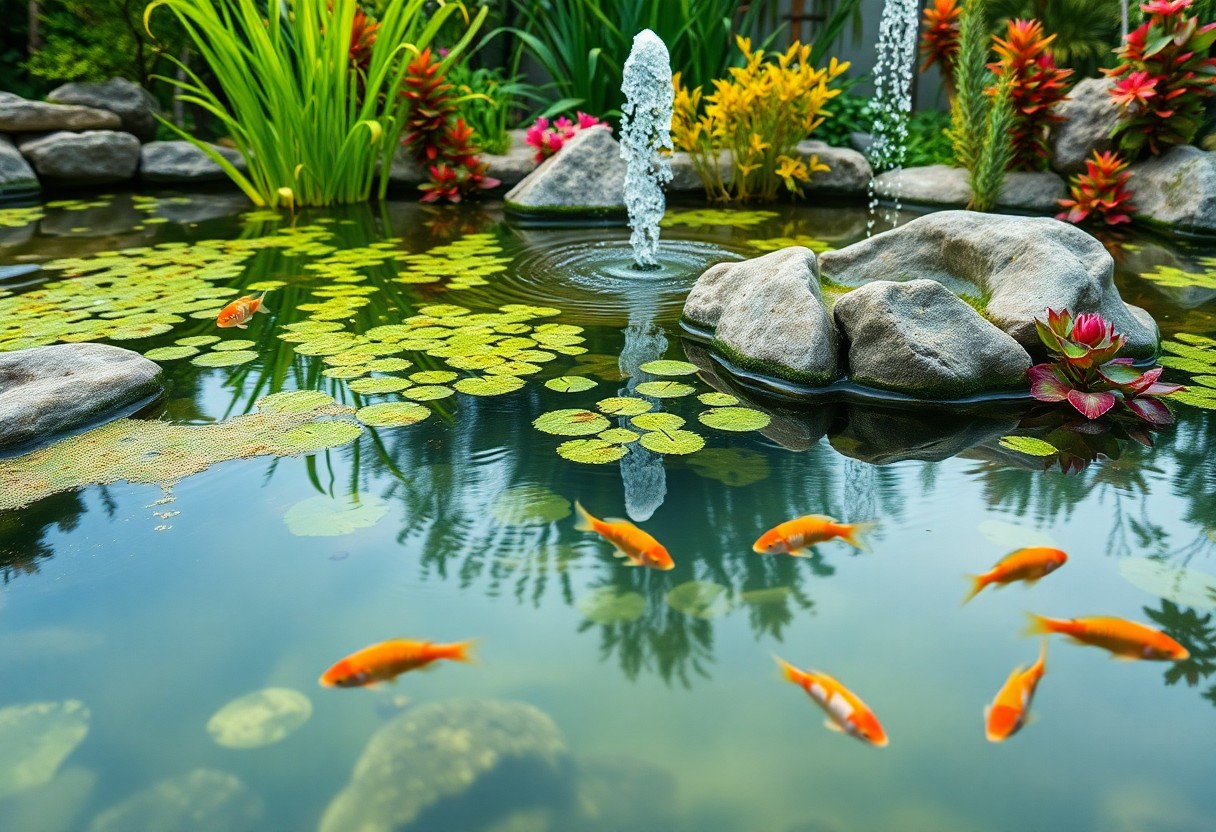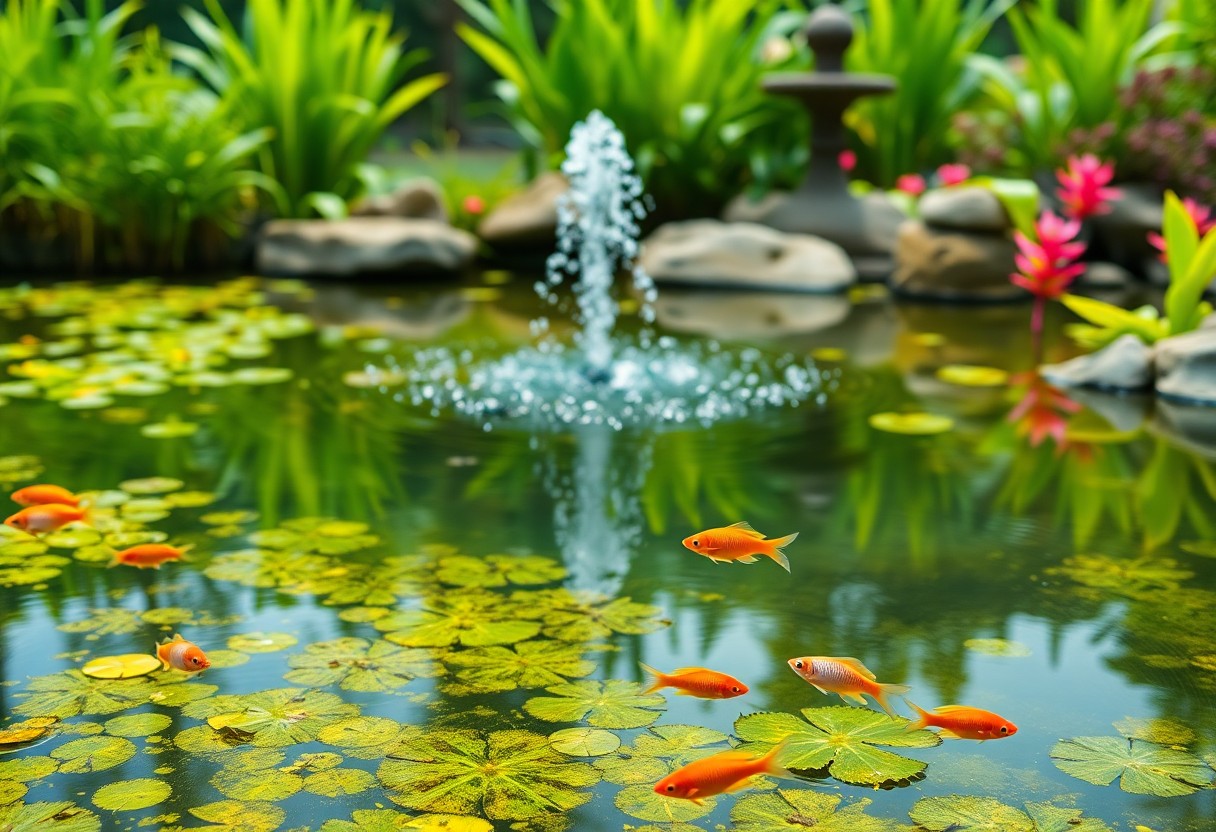Problems with algae growth can quickly turn your serene pond into a green, murky mess. You might find yourself overwhelmed as this invasive organism not only mars the beauty of your water feature but can also harm your fish and plants. By understanding the factors that contribute to this issue, you can take proactive steps to maintain a balanced ecosystem in your pond. In this post, you will discover proven strategies to keep your pond clear and thriving, allowing you to enjoy the tranquility and abundance of aquatic life without the stress of algae.

Table of Contents
Key Takeaways:
- Maintain a balanced ecosystem by ensuring proper fish stocking levels to prevent overcrowding and excessive waste.
- Regularly test and monitor water quality parameters, including pH, nitrogen, and phosphorus levels, to identify potential issues early.
- Utilize aquatic plants strategically, as they can naturally compete with algae for nutrients and provide shade to reduce sunlight exposure.
- Implement a schedule for routine pond maintenance, including removing debris and organic materials that contribute to nutrient buildup.
- Consider introducing beneficial bacteria or enzymes into the pond to promote decomposition and improve overall water quality.
Understanding Pond Ecosystem Basics
A pond is a complex ecosystem that includes various interactions among animals, plants, and microorganisms. By appreciating these relationships, you can maintain the health of your pond and prevent issues like algae growth. A balanced ecosystem promotes fish health and enhances water quality, providing a more visually appealing and resilient aquatic environment.
Water Quality Factors
To maintain a thriving pond environment, focus on these key water quality factors:
- pH levels
- oxygen content
- nutrient levels
- temperature
Perceiving these aspects will help you identify potential problems before they escalate.
Natural Balance Components
Components that contribute to the natural balance of your pond include aquatic plants, fish populations, and microorganisms. This diverse mix helps in the breakdown of organic matter, and the presence of beneficial bacteria is especially important as they aid in water purification. Active plants not only provide oxygen but also offer habitat for various species, promoting ecosystem stability. It is vital to monitor these components closely and ensure they are in proportion to maintain a harmonious environment.
Common Pond Problems
Assuming you are a pond owner, understanding the common pond problems is crucial for maintaining a healthy ecosystem. Issues like algae growth, poor water quality, and debris accumulation often arise, which can disrupt the natural balance and affect the aesthetic appeal of your pond. Regular monitoring and proper management techniques can help you mitigate these problems effectively.
Types of Algae Growth
Assuming you have some knowledge, it’s important to identify different types of algae growth that can plague your pond:
| Type | Description |
| Green Algae | Thin layers on the surface of the water. |
| Blue-Green Algae | Can produce toxins harmful to wildlife. |
| Filamentous Algae | Looks like green hair, often clumping together. |
| Chara | A leafy green, often mistaken for higher plants. |
| Diatoms | Brownish algae, can coat pond surfaces. |
Perceiving these types helps you take timely actions for control.
Water Clarity Issues
Assuming your pond’s water clarity is less than ideal, it is crucial to address it promptly. Various factors contribute to murky water, including algae blooms, organic debris, and sediment buildup. Ensuring that your pond has adequate filtration and aeration can significantly improve clarity and promote the health of aquatic life.
A well-maintained pond requires regular attention to water clarity issues, as murky water can indicate poor ecological health, leading to unwanted growth and dying fish. Sediment accumulation can also block sunlight, which is necessary for submerged plants. In extreme cases, low water clarity can result from toxic algae, which pose a danger to both wildlife and pets. By conducting regular water tests and incorporating biological control measures, you can maintain a clear and healthy pond atmosphere.
Prevention Strategies
Many pond owners face challenges with algae growth and other issues, but implementing effective prevention strategies can alleviate these problems. Familiarize yourself with Common Pond Problems to understand the underlying causes. By taking proactive measures, you can promote a healthy ecosystem and minimize maintenance efforts in the long run.
Proper Pond Design Tips
Design your pond with careful consideration to prevent issues like algae overgrowth. Follow these tips:
- Incorporate proper circulation to distribute nutrients evenly.
- Use submerged plants to absorb excess nutrients.
- Consider the depth and size for optimal water balance.
Perceiving the overall balance of your pond’s features will promote a more stable environment.
Maintenance Best Practices
There’s no escaping that ongoing maintenance is imperative for a thriving pond. Regular checks on water quality, reducing nutrient load, and controlling vegetation help keep your ecosystem in check. Create a routine that includes:
- Testing water parameters regularly.
- Removing debris and excess plant growth consistently.
- Monitoring fish health and population.
Proper maintenance not only aids in preventing algae growth but also promotes overall pond health. By staying proactive, you’ll create a balanced environment where aquatic life can flourish.
Natural Control Methods
Once again, employing natural control methods can be an effective strategy to minimize algae growth in your pond. Utilizing a combination of beneficial plants and managing your fish population creates a balanced ecosystem that helps deter excess nutrients, promoting clear water and overall pond health.
Beneficial Plants Selection
On selecting the right aquatic plants, focus on native species that thrive in your region. These plants not only compete with algae for nutrients and sunlight but also provide habitat for beneficial organisms. By incorporating a variety of submerged, floating, and emergent plants, you can enhance your pond’s ecosystem and improve water quality.
Fish Population Management
You should actively manage your pond’s fish population to create a balanced ecosystem that helps control algae growth. A well-maintained balance of fish species can optimize nutrient cycling while preventing algae overgrowth.
Selection of the right fish species is important for your pond’s health. Goldfish and some types of minnows are great for controlling algae, while overpopulation of larger fish can lead to excessive nutrients in the water. The ideal strategy includes maintaining a diverse fish population that facilitates natural predation on algae and deters problematic growth. Regularly assessing and adjusting your fish stock is necessary to maintaining this balance and keeping algae at bay.
Water Treatment Solutions
Keep your pond healthy by exploring effective water treatment solutions. Regularly testing your water quality and implementing appropriate treatments can significantly reduce algae growth and maintain a balanced ecosystem. Solutions like specialized pond chemicals and natural additives can help you control nutrient levels, while regular maintenance practices can keep your water clean and clear.
Filtration Systems Guide
Solutions for proper filtration include choosing the right type for your pond’s size and water volume. Mechanical, biological, and ultraviolet filtration systems work together to remove debris, improve water clarity, and manage harmful pathogens. Consider factors such as energy efficiency and ease of maintenance when selecting a filtration system that fits your specific needs.
Aeration Techniques
To enhance your pond’s water quality, consider implementing effective aeration techniques. Aeration introduces oxygen into the water, promoting the growth of beneficial bacteria while discouraging algae blooms. Adding aerators such as fountains, air pumps, or submerged diffusers can help improve circulation and maintain a healthy balance in your pond’s ecosystem.
Understanding how aeration techniques work can greatly enhance the health of your pond. By increasing oxygen levels, you support the growth of beneficial bacteria that compete with algae for nutrients. This reduces the risk of unwanted algae growth and enhances water clarity. Proper aeration also improves water circulation, preventing stagnation and the buildup of harmful toxins. Implementing these techniques will lead to a healthier environment for your aquatic life and an aesthetically pleasing pond.
Seasonal Maintenance Tips
Not maintaining your pond seasonally can lead to serious algae growth. Here are some tips to keep your pond healthy:
- Regularly clean debris and leaves.
- Check and manage water circulation.
- Test water quality frequently.
- Monitor and maintain aquatic plants.
Assume that following these seasonal maintenance tips will help you enjoy a crystal-clear pond year-round. For more insights, check out Preventing Algae Blooms Through Smart Pond Management.
Spring and Summer Care
For optimal spring and summer care, focus on removing debris and adjusting the aquatic plant balance. Ensure your pond’s ecosystem remains healthy by encouraging the growth of beneficial plants that compete with algae for nutrients.
Fall and Winter Preparations
Fall is the perfect time to prepare your pond for winter. You should start by removing leaves and excess debris that can decay and lead to further water quality issues.
Plus, establishing a solid plan for winter will help protect your pond. Ensure that you reduce fish feeding as temperatures drop and inspect equipment for any necessary repairs. Proper winterization prevents ice damage and maintains your pond’s overall stability. Take these steps seriously, as inadequate preparation can lead to significant setbacks in maintaining a healthy pond environment.
To wrap up
As a reminder, to avoid common pond problems like algae growth, you should regularly monitor water quality, maintain balanced nutrient levels, and incorporate natural filtration methods. By managing your pond’s ecosystem through proper planting, ensuring adequate aeration, and controlling sunlight exposure, you can significantly reduce algae growth. Regular maintenance and proactive measures will help you keep your pond healthy and visually appealing, allowing you to enjoy it to the fullest. Stay vigilant, and your efforts will pay off with a vibrant, thriving aquatic environment.
Q: What causes algae growth in ponds?
A: Algae thrive in ponds due to an excess of nutrients, particularly nitrogen and phosphorus. These nutrients often come from organic matter decay, runoff from fertilizers, and animal waste. When sunlight and warmth combine with ample nutrients, algae can grow rapidly, leading to unsightly blooms that disrupt the pond ecosystem.
Q: How can I prevent nutrient runoff from entering my pond?
A: To reduce nutrient runoff, consider establishing buffer zones with native plants along pond edges. These plants can help absorb nutrients before they reach the water. Additionally, avoid using chemical fertilizers in nearby landscaping, and implement erosion control measures to prevent soil loss during heavy rains, which often carry nutrients into the pond.
Q: What role does aeration play in maintaining pond health?
A: Aeration increases water circulation and introduces oxygen into the pond, which is necessary for aquatic life. This process helps to break down organic matter more efficiently, reducing the buildup of nutrients that can lead to algae growth. By maintaining proper aeration, you can create a balanced pond ecosystem that discourages algae proliferation.
Q: Are there any natural ways to control algae growth in ponds?
A: Yes, introducing beneficial bacteria or enzymes can help manage nutrient levels in your pond naturally. These products break down organic materials, reducing nutrient availability for algae. Additionally, adding aquatic plants like water lilies can help shade the water, limiting sunlight that fuels algae growth while providing habitat for wildlife.
Q: How often should I monitor my pond’s water quality?
A: Regular monitoring is important for successful pond management. Checking water quality at least once a month will help you track changes in nutrient levels, pH, and dissolved oxygen. If any irregularities are detected, you can take timely actions to address potential problems before they escalate, ensuring a healthier pond environment.

